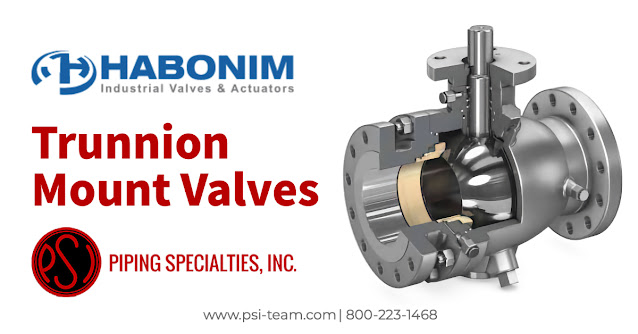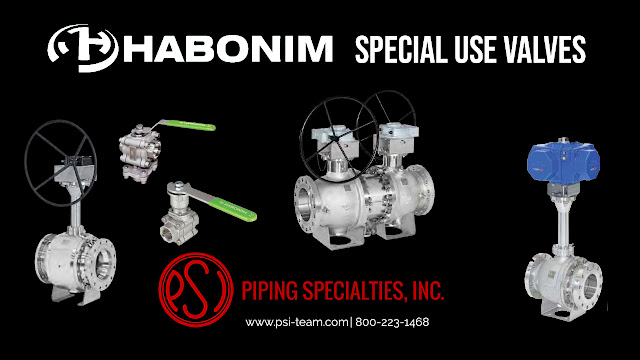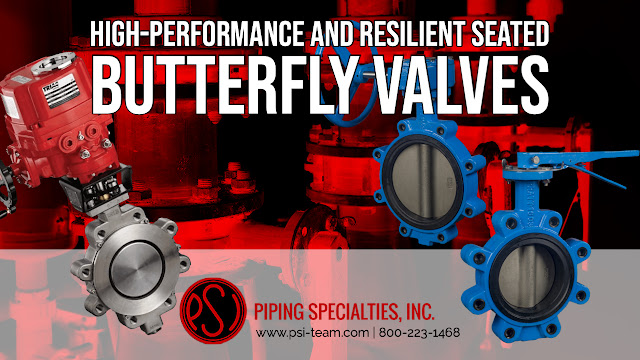Piping Specialties Inc. (PSI) is one of the northeast's largest suppliers of valves; process controls/instrumentation, and engineered mechanical specialties. Industries served: Power Generation, Pulp/Paper, HVAC, Water/Wastewater, Food/Beverage, Life Sciences, Chemical/ Process, Semiconductor. For more information visit PSI-Team.com or call 800-223-1468.
Process Refractometers - The Vaisala Polaris™ Product Family
Trunnion Mount Valves
The Role of Metal Expansion Joints
- Lateral movement: Metallic expansion joints can accommodate lateral movement, which is movement in a side-to-side direction. This is important in systems that are subjected to thermal expansion and contraction, as the pipes will expand and contract due to temperature changes.
- Angular movement: Metallic expansion joints can also accommodate angular movement, which is movement in a rotational direction. This is important in systems that are subjected to vibration, as the pipes will vibrate due to the flow of fluid or gas.
- Axial movement: Metallic expansion joints can also accommodate axial movement, which is movement in a back-and-forth direction. This is important in systems that are subjected to misalignment, as the pipes may not be perfectly aligned.
- In addition to providing flexibility, metallic expansion joints also help to reduce noise and vibration, and they can protect against the effects of corrosion, erosion, and abrasion. They are often used in a variety of industries, including power generation, petrochemical, pharmaceutical, and food and beverage.
Cryogenic Ball Valves
- LNG (Liquefied Natural Gas) storage and transfer: Cryogenic ball valves are used to control the flow of LNG in storage tanks and transfer lines.
- Cryogenic tanks and vessels: Cryogenic ball valves are used to control the flow of cryogenic fluids in tanks and vessels used for storage and transportation.
- Refrigeration and air conditioning: Cryogenic ball valves are used in refrigeration and air conditioning systems to control the flow of refrigerants and other coolants.
- Industrial gases: Cryogenic ball valves are used in the production, storage, and distribution of industrial gases such as oxygen, nitrogen, and argon.
- Chemical and petrochemical processing: Cryogenic ball valves are used in the production and transportation of chemical and petrochemical products that require low temperatures for processing or storage.
- Aerospace and defense: Cryogenic ball valves are used in aerospace and defense applications to control the flow of cryogenic fluids in satellites, rockets, and other space vehicles.
Reotemp MSX HF Safety Pressure Gauge for Use in Hydrofluoric Acid Service
Control Valves, Actuators, and Positioners
Commonly, valves are operated with handwheels or levers, although some must be regularly opened, closed, or throttled. In certain conditions, it is not always practical to position valves manually; hence actuators are employed instead of hand wheels or levers.
An actuator is a mechanism that moves or regulates a device, such as a valve. Actuators decrease the requirement for people to operate each valve manually. Valves using actuators can remotely control valve position, particularly crucial in applications where valves open and close or modulate fast and precisely.
Pneumatic, hydraulic, and electrical actuators are the three fundamental types.
- Pneumatic actuators employ air pressure to generate motion and are probably the most prevalent type of actuator utilized in process systems.
- Actuators powered by a pressurized liquid, such as hydraulic fluid, are called hydraulic actuators. Typically, hydraulic actuators of the same size produce more torque than pneumatic actuators.
- Electric actuators generate motion using electricity. Actuators usually belong to two broad categories: solenoid or motor-driven actuators.
Actuators position valves in response to controller signals and can be positioned rapidly and precisely to accommodate frequent flow variations. The instrumentation systems that monitor and respond to fluctuations in plant processes include controllers. Controllers receive input from other instrumentation system components, compare that input to a setpoint, and provide a corrective signal to bring the process variable (such as temperature, pressure, level, or flow).
You have a control valve when actuators pair with flow-limiting or flow-regulating valves. Generally speaking, control valves automatically restrict flow to provide accurate flow to a process to maintain product quality and safety.
Control valves can be linear, where the stem moves the valve disk up and down like globe valves, or rotational. Rotary control valves include butterfly valves, which open or close with a 90-degree rotation. The pneumatic diaphragm and electric actuators are the most prevalent on linear and rotational control valves.
Some valves require long stem travel or substantial force to change position. A piston actuator's higher torque is preferable to diaphragm actuators in these situations. Examples of piston actuators are rack and pinion and scotch-yoke designs.
Single-acting piston actuators control the air pressure on one side of a piston, and with higher air pressure, the piston moves within the cylinder and turns the valve. The air on the opposite side of the piston exits the cylinder via an air vent. With decreased air pressure, the spring expands, causing the piston to move in the opposite direction.
If air pressure falls below a predetermined threshold or is lost, the spring will push the piston to the desired position, referred to as the "fail" position (open or closed).
A double-acting piston actuator lacks a spring and has air supply ports on both ends of the cylinder. Increasing air pressure to the supply port moves the valve in one direction. Higher pressure air entering from the opposite supply port pushes the valve in the opposite direction. Filling the cylinder with air and releasing air from the cylinder is regulated by a device known as a positioner.
Typically, the control of pneumatic actuators occurs from air signals from a controller. Some actuators react directly from a controller, for instance, a 3-15 PSI controller pneumatic output. Sometimes, a controller signal alone cannot counteract friction or fluid pressure. This situation requires a separate, higher-pressure air supply and modulating it with a pneumatic or electro-pneumatic positioner. These devices regulate a higher-pressure air supply to ensure that an actuator has enough torque to position a valve accurately. The positioner responds to a change in the controller's air, voltage, or current signal and proportions the higher pressure air to the actuator. Connecting the actuator stem to the positioner is a mechanical linkage. This mechanical connection is also known as a feedback connection. As the actuator stem moves up or down, or rotationally, the link likewise moves. The location of the connection informs the positioner when sufficient movement coincides with the controller's air signal. The controller's signal transmits to the positioner instead directly to the actuator, and the positioner regulates the air supply provided to the actuator.
Like other process components, actuators are prone to mechanical issues. Since actuator issues can negatively impact the operation of a process, it is essential to be able to recognize actuator issues when they occur. Frequently, an operator can notice an actuator fault by comparing the valve position indication to the position specified by the controller. For instance, if the position indicator shows the valve closed, but the flow indicator on the controller indicates that flow is still passing through the valve, the valve seat and disc are likely worn, enabling leakage through the valve.
Because there are so many different styles and designs of actuators, positioners, and valves and so many industrial applications, the combination possibility matrix is vast. You must discuss your application with a knowledgeable, experienced valve expert. The success of your project in terms of product quality, system cost, maintenance, and safety depends upon it.
What Is the Total HermetiX™ Integrity Package?
Habonim provides the best valve and actuation solutions for the most demanding industries, including oil and gas, chemical, petrochemical, pharmaceutical, and mining.
As a standard, most Habonim valves include the Total HermetiX™ Integrity Package. This package has three main elements plus superior inline sealing mechanisms in some of them:
DOUBLE BODY SEALING
- Body-to-ends & body-to-bonnet double sealing for superior atmospheric sealing.
- Selection of sealing materials for diverse applications.
- Fugitive emission prevention.
ZERO FUGITIVE EMISSION - NO MAINTENANCE STEM SEALING
- Patented HermetiX™ stem sealing design with zero fugitive emission sealing capability.
- Tested or certified according to ISO 15848-1 and API641 standards.
- Up to 500,000 cycles of operation with no maintenance guaranteed.
- Field-proven for millions of cycles of continuous operation.
FIRE SAFE
- Tested and certified according to API 607 and ISO 10497.
- Type-tested and approved by leading certification bodies for marine service.
- Clean-Fire Safe construction guarantees no graphite contamination of the media flow.
For more information about Habonim products in New England contact:
Habonim Special Use Valves
Habonim develops, designs, manufactures, tests, supplies and service ball valves for the global market and is globally leading in some segments of ball valve usage. With high-end products, uncompromised quality, serviceability and innovation to create solutions for the most demanding applications Habonim has gained a long track record of proven success. Habonim’s ball valve product line supports extreme cold to extreme heat systems, industrial use up to very high pressures, and meets the specific needs and regulations of a wide range of industries.
HABONIM offers ball valves in a variety of design styles and technologies that is most effectively supports a wide range of applications and use cases. We offer Floating ball style valves and Trunnion-mounted ball style valves with several construction methods.
DOWNLOAD THE HABONIM SPECIAL USE VALVE CATALOG HERE
For more information about Habonim products in New England contact:
Protective Coating Options for the Series 3R Rack and Pinion Actuators
SIL Level Switch Is Specifically Designed for Floating Roof Tanks
- Loop or Line Powered
- Wetted Parts: 316SS 3/4" NPT Mounting, 3/16" FEP insulated flexible and adjustable cable, non-sparking brass sensor.
- Automatic and local or remote manual test functions ensure proper system operation.
- One system fits most floating roof tank applications, reducing field spans
- Adjustable insertion lengths up to 15' (4,6m)
- Excellent trip point accuracy over a wide range of medias and tank roof
High-performance and Resilient Seated Butterfly Valves for Commercial and Industrial Applications
A butterfly valve has a disc that is in the fluid flow path. In the most common style of butterfly valve, the disc revolves around a central axis, the stem, via a 90-degree arc from parallel to the flow direction (open) to perpendicular to the flow direction (closed). Butterfly valves have a straightforward design with few moving components, making them simple to repair and maintain. The valve has four main parts: the body, the stem, the disk, and the seat.
The butterfly disk is always in the flow path, but its thin profile has little effect on flow. Butterfly valves are popular because they provide tight shut-off, are available in various materials and sizes, and may be easily automated using a variety of quarter-turn electric and pneumatic actuators.
You'll find butterfly valves in a wide range of industrial applications, from managing the flow of water to handling far more hazardous industrial fluids. Many industries use butterfly valves, including water treatment, chemical processing, pulp, paper manufacturing, food processing, power generation, etc.
There are two primary classifications of butterfly valves:
- High-performance butterfly valves (HPBV)
- Resilient seated butterfly valves
High-performance butterfly valves include carbon or stainless steel bodies with Teflon seats and can withstand more significant pressures and temperatures. Resilient seated valves usually feature ductile iron or aluminum bodies and operate at lower pressures and temperatures.
Butterfly valve bodies are available in two mounting styles: lug and wafer. Lug bodies include cast-in lugs with bolt hole designs that match pipe flanges. A wafer body valve does not have a mounting hole pattern, and mounting is facilitated by sandwiching the valve between two pipe flanges, with mounting bolts around the valve body. Wafer-style bodies are less costly. An advantage to lug body valves is their use as a dead-end valve, whereas wafer valves are unsuitable for this service.
The stem is a one or two-piece shaft that keeps the disk in place and provides the rotational torque that allows the disk to open and shut. The stem of resilient seated valves has protection from the process media by packing rings, allowing for a more cost-effective solution to regulate the valve's application to various potentially corrosive media. High-performance butterfly valve stems come into touch with process media and must be media suitable.
The disk is the valve component that comes into direct contact with the process medium and regulates flow. Disks are available in various materials and optionally come with corrosion-resistant polymer coatings. Some butterfly valves include contoured disks that are carefully aligned with the stem to increase flow control, modify torque needs, or give the valve a longer life.
A resilient seated valve closes via an "interference fit," which means the disk forces itself into the seat. The seat is the soft substance (polymer elastomer) including Buna-N and Nitrile, and should be specified depending on the process medium involved.
High-performance butterfly valves use an interference fit as well, but with significantly tighter tolerances, but also ensure tight seating with assistance from upstream pressure. PTFE or RTFE are the most often used materials for HPBV seats. Metal seats on HPBVs accommodate more significant pressure and temperature applications.
Like other valves, butterfly valves have applications in which they outperform. To apply the optimum solution to your flow control applications, combine your process knowledge with your product knowledge with the application skills of a proven valve engineering professional. Contact Piping Specialties, Inc. for more information about industrial valves. Visit https://psi-team.com or call 800-223-1468.
Industrial Thermowell Process Connection Types
Water Cut Meters from Drexelbrook
Water cut meters measure the water cut (or BS&W) of oil flowing from a well, a separator, crude oil transfer in pipelines, and tanker loading.
Piping Specialties is Your Preferred Ball Valve Automation Specialist in New England
Contact Piping Specialties / PSI Controls with your next automated ball valve requirement.
Extremely Durable 4.5 Inch Process Gauges
Series PT45P Features
- Safety Pattern Design
- Solid Front/Blowout Back Safety Case
- All Stainless Steel Internal Parts
- Internal Overload and Underload Stops
- Field Fillable Case
- Micro-Adjustable Pointer with Floating Zero
- ASME B40.100 Design
- NACE MR-0175 and MR-0103 Compliant
HABONIM 50 Series Top Entry Cryogenic Ball Valves
Due to its unique one-piece body structure, the HABONIM Series 50 Top Entry Valve is the ultimate answer for pipeline integrity on the one hand and inline serviceability on the other.
The 50 Series of HABONIM bidirectional top entry cryogenic ball valves are a modern adaption of a trunnion ball valve with top entry construction and patent-pending new design elements.
The main challenge for an assembly or maintenance team with a standard top entry valve is usually the complexity of assembly and disassembly of the valve inner parts, the time-consuming operation, and the requirement for special equipment and jigs.
All of these problems are addressed and solved by HABONIM's Series 50 top entry valve design.
Upon removing the valve bonnet screws, the crew has immediate access to the valve's interior parts, allowing for thorough maintenance and replacement of all inner components and sealing. This one-of-a-kind design provides for complete valve renovation inline without the need to remove any insulation pieces.
One Double Piston Effect (DPE) dynamic seat is used in the patent-pending design, allowing bidirectional sealing under the full differential and a relatively simple design with few parts and no closed cavities. These qualities provide all of the advantages of a ball valve's high flow (Cv) with no restriction on flow direction or sealing, as well as a safer cryogenic construction.
When installed, a patent-pending supplementary optional body extender raises the valve's bonnet above piping insulation, allowing the valve to be maintained without removing the insulation or without special valve insulation boxes.
The valve's revolutionary design allows for quick inline serviceability with minimal effort and inexpensive equipment for valve dismantling, replacement, and reassembly.
For more information in New England, contact Piping Specialties. Call 800-223-1468 or visit https://psi-team.com.
Food Industry Batch Level Control
- 3A designed sanitary sensing elements
- No moving parts
- 3 control points on one vertical sensing element
- Cote-Shield circuitry eliminates false alarms due to coatings
- Designed to endure Clean In Place (CIP) demands
All Stainless Steel Ball Valve and Actuator Systems
Stainless steel pneumatic actuators are available in spring return, double acting, fail open, and fail close configurations. A corrosion resistance surface - resistance to most corrosive materials - is one of the advantages of using a stainless steel actuator. The stainless steel pneumatic actuator is excellent for heavy-duty automation, especially in corrosive environments. Stainless steel actuators with a durable stainless steel body manufactured to NAMUR standards continue to perform in the harshest environments.
Piping Specialties' stainless steel actuated ball valves provide exceptional accuracy and dependability in flow control and open/close operations, critical in manufacturing, chemical, oil & gas, wastewater, processing, and other applications.
Piping Specialties is committed to providing the most suitable valve for your application. For more information about stainless steel valves, call 800-223-1468 or visit https://psi-team.com.














